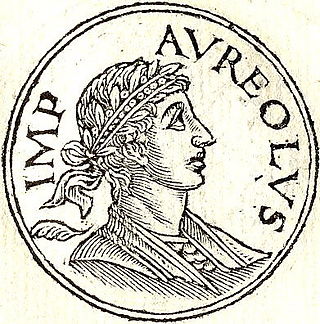
Publius Licinius Egnatius Gallienus was Roman emperor with his father Valerian from 253 to 260 and alone from 260 to 268. He ruled during the Crisis of the Third Century that nearly caused the collapse of the empire. He won numerous military victories against usurpers and Germanic tribes, but was unable to prevent the secession of important provinces. His 15-year reign was the longest in half a century.
Year 254 (CCLIV) was a common year starting on Sunday of the Julian calendar. At the time, it was known as the Year of the Consulship of Valerianus and Gallienus. The denomination 254 for this year has been used since the early medieval period, when the Anno Domini calendar era became the prevalent method in Europe for naming years.
The 230s decade ran from January 1, 230, to December 31, 239.
The 250s was a decade that ran from January 1, 250, to December 31, 259.
The 260s decade ran from January 1, 260, to December 31, 269.
The 280's decade ran from January 1, 280, to December 31, 289.

Year 303 (CCCIII) was a common year starting on Friday of the Julian calendar. It was known in the Roman Empire as the Year of the Consulship of Diocletian and Maximian. The denomination 303 for this year has been used since the early medieval period, when the Anno Domini calendar era became the prevalent method in Europe for naming years.

Year 260 (CCLX) was a leap year starting on Sunday of the Julian calendar. At the time, it was known as the Year of the Consulship of Saecularis and Donatus. The denomination 260 for this year has been used since the early medieval period, when the Anno Domini calendar era became the prevalent method in Europe for naming years.

Valerian was Roman emperor from 253 to spring 260 AD. Valerian is known as the first Roman emperor to have been taken captive in battle, captured by the Persian emperor Shapur I after the Battle of Edessa, causing shock and instability throughout the Roman Empire. The unprecedented event and his unknown fate generated a variety of different reactions and "new narratives about the Roman Empire in diverse contexts".

Fulvius Macrianus, also called Macrianus Major, was a Roman usurper. He was one of Valerian's fiscal officers. More precisely, sources refer to him as being in charge of the whole state accounts or, in the language of a later age, as Count of the Treasury and the person in charge of markets and provisions. It seems almost certain that he was an Equestrian. The Historia Augusta claims that he was the foremost of Valerian's military commanders, but that is most likely a gross exaggeration, if not entirely fictitious. He followed Valerian during his ultimately catastrophic campaign against the Persians in 259 or 260; however, he remained at Samosata during the fatal battle of Edessa and his role in the events before and after the battle is questionable. After Valerian's capture by Sassanid Emperor Shapur I, Valerian's son Gallienus became sole emperor, but was occupied with his own problems in the West. Macrianus grabbed the opportunity. With the support of Balista, one of Valerian's military commanders, and with the influence that possession of the treasury of Valerian brought, Macrianus managed to have his two sons Macrianus Minor and Quietus elevated to the throne. He himself was not able to assume the purple because he was deformed in one of his legs.

Titus Fulvius Iunius Macrianus, also known as Macrianus Minor, was a Roman usurper. He was the son of Fulvius Macrianus, also known as Macrianus Major.

Titus Fulvius Junius Quietus was a Roman usurper against Roman Emperor Gallienus.

Aureolus was a Roman military commander during the reign of Emperor Gallienus before he attempted to usurp the Roman Empire. After turning against Gallienus, Aureolus was killed during the political turmoil that surrounded the Emperor's assassination in a conspiracy orchestrated by his senior officers. Aureolus is known as one of the Thirty Tyrants and is referenced in ancient sources including the Historia Augusta, Zonaras' epitome and Zosimus' Historia Nova.
Macriani is the name of three Roman usurpers – a father and two sons – who tried to gain the Roman throne from Emperor Gallienus. All three died in 261 A.D. They were:
Balista or Ballista, also known in the sources with the name of "Callistus", was one of the Thirty Tyrants of the controversial Historia Augusta, and supported the rebellion of the Macriani against Emperor Gallienus.

Valens Thessalonicus was a Roman usurper during the reign of Emperor Gallienus.
Lu Ji, courtesy name Shiheng, was a Chinese essayist, military general, politician, and writer who lived during the late Three Kingdoms period and Jin dynasty of China. He was the fourth son of Lu Kang, a general of the state of Eastern Wu in the Three Kingdoms period, and a grandson of Lu Xun, a prominent general and statesman who served as the third Imperial Chancellor of Eastern Wu.
The Gallienus usurpers were the usurpers who claimed imperial power during the reign of Gallienus. The existence of usurpers during the Crisis of the Third Century was very common, and the high number of usurpers fought by Gallienus is due to his long rule; fifteen years being considered long by the standards of the 3rd century Roman Empire.

Lucius Calpurnius Piso Frugi was probably a Roman general whom the imperial pretender Macrianus Major sent to suppress the governor of Achaia, Valens Thessalonicus. His existence is attested only by the unreliable Historia Augusta, which labels Piso as one of several usurpers who plagued the reign of Emperor Gallienus. While some historians grudgingly regard Piso as a historical figure, many reported details of his life, including his usurpation, are dismissed as fabrications.










